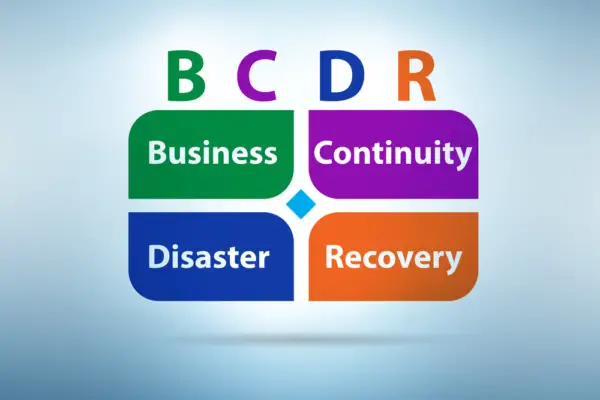Business Continuity Planning (BCP) is important because it provides a framework to ensure a company can operate during and after a disaster or significant disruption. Here are several reasons why BCP is critical:
- Protects Revenue and Reputation: A BCP helps prevent financial loss and protects the company’s reputation by ensuring critical operations can continue. (Travelers Insurance)
- Maintains Customer Service: It allows a company to maintain customer service levels, thus preserving customer trust and loyalty. (Convene)
- Minimizes Downtime: A BCP establishes procedures to reduce downtime and accelerate recovery, limiting the negative impact on operations. (TechTarget)
- Compliance with Regulations: Many industries have regulations requiring businesses to have continuity plans to ensure the protection of data and the ability to operate during and after an emergency. (Deloitte Ireland)
- Employee Safety and Job Security: A BCP prioritizes employee safety in an emergency and helps to secure jobs by ensuring the business can survive and recover. (Convene)
- Strategic Advantage: A robust BCP can provide a competitive advantage, demonstrating to stakeholders that the company is resilient and reliable. (Deloitte Ireland)
- Risk Management: It helps identify and manage risks, ensuring the company can swiftly respond to and recover from various disruptions. (TechTarget)
Overall, BCP is essential for the resilience of a business, enabling it to handle crises effectively and maintain operations under adverse conditions.
In today’s fast-paced and unpredictable business landscape, organizations must have a solid plan to ensure their operations can continue smoothly, even in unexpected disruptions.
This is where business continuity planning comes into play. By proactively identifying potential threats and developing strategies to mitigate their impact, businesses can safeguard their reputation, maintain customer trust, and minimize financial losses.

But why is business continuity planning so important? Let’s explore the key reasons together and discover how it can make a difference for any organization.
Key Takeaways
- Business continuity planning is crucial for organizations to ensure continuous operations during and after disruptive events.
- It helps organizations minimize financial losses, maintain customer trust, and safeguard their reputation.
- Key components of a Risk assessment: Business Continuity Plan Risk Assessment” href=”https://riskpublishing.com/business-continuity-plan-risk-assessment/” rel=”noopener”>business continuity plan include risk assessment, emergency response plan, communication strategy, and restoration and recovery of business functions.
- Potential threats and disruptions that organizations should be prepared for include natural disasters, technological failures, cyber attacks, and data breaches.
Definition of business continuity planning
Business continuity planning is the systematic process of creating and implementing strategies and procedures to ensure that an organization can continue its critical functions and operations during and after a disruptive event. This aims to clearly define business continuity planning in a concise and structured manner.
Business continuity planning is of utmost importance for organizations as it helps them prepare for potential disruptions and minimize the impact on their operations.
It involves identifying potential risks, assessing their impact, and developing mitigation strategies.
The goal is to ensure the organization can effectively respond to and recover from any disruption, such as natural disasters, cyber-attacks, or supply chain disruptions.
Importance of business continuity planning in today’s world
Given the ever-increasing risks and uncertainties organizations face today, the significance of business continuity planning cannot be overstated.
In today’s world, where disasters and disruptive events can strike at any moment, having a well-defined business continuity plan is crucial for organizations to ensure their survival and minimize the potential threats they face.
Business continuity planning involves conducting a thorough Business impact analysis to identify potential risks and vulnerabilities that could impact operations.
This analysis helps organizations understand the financial impact of an unexpected event and allows them to develop a recovery strategy to mitigate the effects.
To emphasize the importance of business continuity planning, consider the following table:
| Potential Threats | Business Impact |
|---|---|
| Natural disasters | Property damage, loss of revenue |
| Cyberattacks | Data breaches, reputational damage |
| Supply chain disruptions | Inability to meet customer demands |
| Employee health issues | Workforce shortage, decreased productivity |
| Power outages | Operational downtime, loss of critical data |
Business Processes and Owners: Effective business continuity planning is crucial for safeguarding critical business processes. Business owners play a pivotal role in ensuring that plans are comprehensive and address all potential vulnerabilities.
A successful business continuity plan must factor in unpredictable events and potential major disasters to maintain essential services without interruption.
It’s the responsibility of company leaders to prioritize regular testing and updates to the plan to account for evolving risks such as human error and changing operational functions.
Human Resources and Continuity Strategy: Human resources form the backbone of any business continuity strategy. The involvement of HR is vital in maintaining normal operations during a business disruption.
Activities conducted by business continuity professionals, in collaboration with HR, aim to minimize the impact on employees and ensure that the workforce is prepared and resilient.
A comprehensive business continuity plan must include strategies to manage human-centric risks, reinforcing the importance of HR in the planning process.
Business Continuity Risks and Leadership: Business leaders must be acutely aware of the various business continuity risks that can affect their organizations.
Adherence to standards for business continuity, possibly involving consultation with a business continuity consultant, is essential for developing an effective plan.
Utilizing a business continuity plan template can provide a solid foundation, but leaders must ensure their plans are tailored to their specific organizational needs.
The planning process should encompass all components of business continuity, including the consideration of real-world events like weather-related incidents and power disruptions.

Operational Resilience and Strategic Planning: A strong business continuity plan is a strategic advantage, contributing significantly to the competitive advantage of an entire organization.
It ensures the continuity of critical operations but also aids in maintaining employee productivity in the face of a disruptive incident.
Incident management and tabletop exercises are integral to this strategy, helping test and refine the plan. Additionally, securing the proper insurance coverage is crucial in providing a financial safety net.
Emergencies and Market Impact: When a disaster strikes, lacking a detailed plan can lead to peripheral damage, including loss of market share and reputational harm.
Business continuity planning must, therefore, encompass a range of scenarios, from severe weather to disease outbreaks.
The involvement of senior management is essential in this process, as their strategic vision and decision-making are critical in guiding the organization through unforeseen disruptions.
Organizational Resilience and Expertise: The concept of resilience in business continuity planning extends beyond merely reacting to incidents; it involves building an organizational culture that can adapt to unexpected situations.
Regular involvement of business continuity experts and an annual schedule for reviewing and updating the continuity plans ensure that the organization remains prepared.
A well-prepared business continuity plan encompasses a thorough business continuity analysis and impact analysis, which are essential for understanding the potential effects of disruptions on the organization’s mission-critical functions.
National Standards and Continuity Guidance: Frameworks and guidelines, such as those provided by the National Institute of Standards and Technology, offer valuable insights into establishing and maintaining acceptable service levels during and after a disruption.
These standards can help guide business continuity professionals in developing plans that ensure the resilience of primary and alternative operational locations.
The strategic advantage of such planning is not just in mitigating risks but also in positioning the organization for strategic growth post-recovery.
Incident Management and Communication: Effective business continuity planning involves robust incident management and clear communication strategies.
This includes establishing emergency contacts and procedures and ensuring that there is a predefined and practiced response when disaster strikes.
The role of communication cannot be overstated, especially in maintaining transparency with stakeholders and ensuring that all employees are informed and prepared.
Integration with Marketing and Financial Planning: Integrating business continuity planning with broader organizational strategies, such as marketing campaigns and financial viability assessments, is crucial.
This alignment ensures that the organization’s strategic planning is comprehensive, considering the potential impact of business disruptions on day-to-day operations and long-term goals.
Senior management plays a key role in this integration, ensuring that organizational risks are adequately addressed in all strategic planning activities.
What is Business Continuity Planning?
Business Continuity Planning (BCP) refers to the process of creating a strategy to ensure the continuous operation of a business in the face of disruptive events.
The main objectives of BCP include minimizing downtime, reducing financial losses, and safeguarding the organization’s reputation.
Key components of a business continuity plan typically include:
- Risk assessment
- Business impact analysis
- Crisis communication
- Recovery strategies.
Definition and objectives of business continuity planning
Establishing measures and procedures to ensure the uninterrupted functioning of an organization during and after a disruptive event is known as business continuity planning.
Risk management is essential to minimize the impact of unforeseen events and ensure the organization’s ability to continue operations.
The importance of business continuity planning cannot be overstated. Organizations can minimize downtime, protect their reputation, and maintain customer confidence by proactively identifying potential risks and developing mitigation strategies.
The objectives of business continuity planning can be summarized in the following table:
| Objectives of Business Continuity Planning |
|---|
| Minimize downtime and ensure uninterrupted operations |
| Protect the organization’s reputation |
| Maintain customer confidence |
| Identify and mitigate potential risks |
| Enable a swift and effective response to disruptions |
Key components of a business continuity plan
What are the essential components of a business continuity plan?
A business continuity plan (BCP) is a vital tool for organizations to mitigate the risks associated with disruptions and disaster situations. It provides a framework for managing and recovering critical business functions in emergency scenarios.
Key components of a BCP include:
- Risk management involves identifying potential threats and assessing their impact on the organization.
- An emergency response plan outlines the procedures to be followed during a crisis.
- Communication strategy: This ensures effective coordination and information dissemination.
- Restoration and recovery of business functions include allocating resources and establishing alternative work arrangements.
These key components ensure that the BCP is comprehensive, contextually relevant, and capable of minimizing the impact of disruptions on business operations.
Benefits of Business Continuity Planning
Business Continuity Planning offers several key benefits to organizations.
Firstly, it helps minimize financial losses by enabling businesses to respond to and recover from disruptive events quickly.
Secondly, it ensures the safety and well-being of employees by having measures in place to protect them during emergencies.
Lastly, Business Continuity Planning helps maintain customer trust and satisfaction and protects the brand reputation by demonstrating the organization’s ability to continue providing products or services even in challenging circumstances.

Minimizing financial losses
Minimizing financial losses is a crucial benefit of implementing effective business continuity planning. Organizations face various financial stability threats, such as natural disasters, cyber-attacks, or economic downturns.
Without a solid business continuity plan, companies risk significant financial losses that can disrupt operations and harm their bottom line.
Business continuity planning involves proactively identifying potential risks and developing mitigation strategies.
Businesses can minimize financial losses in an emergency by assessing vulnerabilities and implementing measures to address them.
This includes having backup systems and technology, ensuring employees are trained to respond effectively to disruptions, and identifying alternative suppliers or service providers.
Ensuring employee safety and well-being
To ensure the well-being of employees, effective business continuity planning prioritizes their safety in the face of potential disruptions and emergencies.
By incorporating employee safety measures into the overall emergency plan, organizations can mitigate potential impacts and ensure the resilience of their workforce.
Here are five reasons why ensuring employee safety and well-being is crucial in business continuity planning:
- Protecting lives and minimizing injuries during emergency situations.
- Maintaining employee morale and productivity during times of crisis.
- Demonstrating the organization’s commitment to employee welfare and building trust.
- Reducing the likelihood of legal and reputational risks associated with employee safety incidents.
- Safeguarding the organization’s talent pool and preventing loss of skilled workers.
Maintaining customer trust and satisfaction
Maintaining customer trust and satisfaction is a crucial element of business continuity planning. Customers rely on organizations to consistently deliver products and services in business interruption or disaster.
Failing to meet customer expectations during such events can lead to negative sentiments, loss of customers, and reputational damage.
Business continuity planning ensures that critical business functions are identified and protected, minimizing the impact of disruptions on customer experience.
Organizations can effectively manage risks and maintain customer satisfaction by developing a robust disaster recovery plan and implementing business resilience strategies.
Business continuity management focuses on understanding customer needs and expectations, establishing communication channels, and promptly addressing customer concerns during times of crisis.
By prioritizing customer trust and satisfaction, businesses can safeguard their reputation and sustain their customer base in challenging situations.
Protecting brand reputation
Business Continuity Planning plays a vital role in safeguarding and enhancing brand reputation. A strong Business Continuity Management program ensures the organization is prepared to handle any potential disruptions that could impact its operations and reputation.
Here are five ways in which Business Continuity Planning protects brand reputation:
- Conducting a Business Continuity Impact Analysis helps identify potential risks and their potential impact on the brand.
- Developing a Business Continuity Policy Statement ensures the organization has a clear and documented approach to managing disruptions.
- Implementing a Business Continuity Management program helps mitigate financial risks, ensuring the organization can continue to deliver its products and services.
- Having a Business Continuity Manager in place ensures that the organization has a dedicated resource to oversee the implementation and ongoing process of the Business Continuity Plan.
- Protecting business premises and critical assets reduces the likelihood of disruptions and helps maintain the organization’s reputation for reliability and resilience.
Understanding Potential Threats and Disruptions
Understanding potential threats and disruptions is crucial for effective business continuity planning.
One important consideration is the identification of natural disasters, such as hurricanes, earthquakes, or floods, which can significantly impact business operations.
Organizations must also be prepared for technological failures and cyber attacks, which can lead to data breaches and system outages.
Lastly, evaluating human-made disasters, such as accidents or sabotage, is essential to ensure comprehensive planning and mitigation strategies.
Identifying natural disasters as potential threats
Natural disasters pose significant threats to business continuity and require careful identification and preparation. Identifying potential natural disasters as threats is essential to business continuity planning.
By understanding the potential risks, organizations can develop effective strategies to minimize damage and ensure the continuity of essential functions.
Here are five natural disasters that can disrupt business operations:
- Hurricanes: Powerful storms that can cause extensive damage to infrastructure and result in prolonged power outages.
- Earthquakes: Sudden and violent ground shaking can lead to structural damage and disrupt operations.
- Floods: Overflow of water that can cause damage to buildings, equipment, and inventory.
- Wildfires: Uncontrolled fires that can destroy entire areas, including business locations.
- Tornadoes: Violent rotating columns of air that can cause severe damage to buildings and infrastructure.
Considering technological failures and cyber attacks
With the ever-increasing reliance on technology in today’s business landscape, organizations must consider the potential threats and disruptions posed by technological failures and cyber-attacks.
Technological failures, such as hardware or software malfunctions, can lead to significant downtime and loss of productivity.
On the other hand, cyber attacks can result in data breaches, financial losses, and reputational damage. To mitigate these risks, businesses must implement robust business continuity planning and disaster recovery strategies.
This involves developing comprehensive security measures, regularly testing systems for vulnerabilities, and creating response plans to address potential cyber threats.
By implementing a business continuity management system, organizations can ensure the continuity of operations and minimize the impact of technological failures and cyber attacks on their business.

| Technological Failures | Cyber Attacks |
|---|---|
| Hardware malfunctions | Data breaches |
| Software malfunctions | Financial losses |
| Downtime and loss of productivity | Reputational damage |
Table 1: Potential disruptions posed by technological failures and cyber-attacks.
Evaluating human-made disasters like accidents or sabotage
Human-made disasters, such as accidents or sabotage, can have a significant impact on business operations and necessitate the implementation of effective business continuity planning strategies.
It is crucial for organizations to evaluate and understand the potential risks associated with human-made disasters to ensure their continuity and resilience.
Here are some key points to consider when evaluating human-made disasters in the context of business continuity planning:
- Conduct a thorough risk assessment to identify potential vulnerabilities and weaknesses within the organization.
- Develop contingency plans and procedures to mitigate the impact of accidents or sabotage.
- Implement security measures and protocols to prevent unauthorized access and protect critical assets.
- Establish clear communication channels to ensure timely response and recovery during a human-made disaster.
- Regularly review and update the business continuity plan to adapt to evolving threats and maintain its effectiveness.
Conducting a Business Impact Analysis (BIA)
Conducting a thorough Business Impact Analysis (BIA) is essential in developing a robust business continuity plan.
The BIA is a systematic process that identifies and assesses the potential impacts of disruptions on an organization’s critical business functions.
By conducting a BIA, businesses can understand the potential consequences of disruptions, such as natural disasters, technology failures, or supply chain disruptions.
This analysis helps prioritize recovery efforts and allocate resources effectively.
Businesses can develop strategies and plans to minimize downtime and mitigate potential losses by identifying the most critical functions and dependencies.
The BIA provides valuable insights into disruptions’ financial, operational, reputational, and regulatory impacts, enabling organizations to develop proactive measures and ensure their ability to recover quickly and efficiently.
Thus, conducting a BIA is crucial in business continuity planning.
Conclusion
Business continuity planning is vital in today’s world to ensure the survival and success of organizations.
It allows businesses to identify potential threats and disruptions, assess their impact, and develop mitigation strategies.
By implementing a business continuity plan, companies can protect their assets, maintain operations during crises, and minimize financial losses.
It is crucial for organizations to prioritize business continuity planning to enhance resilience and ensure their long-term sustainability.

Chris Ekai is a Risk Management expert with over 10 years of experience in the field. He has a Master’s(MSc) degree in Risk Management from University of Portsmouth and is a CPA and Finance professional. He currently works as a Content Manager at Risk Publishing, writing about Enterprise Risk Management, Business Continuity Management and Project Management.

